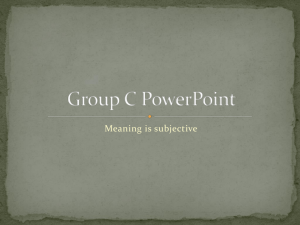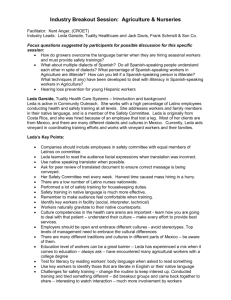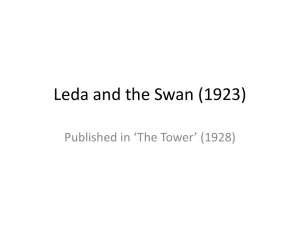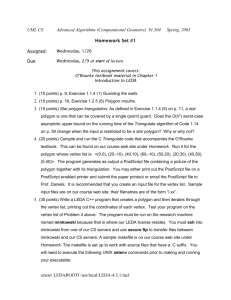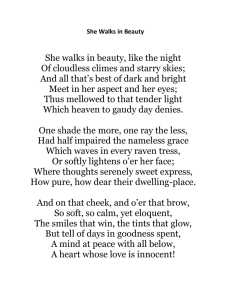François Gillet presentation at ENSACT Congress 2013
advertisement
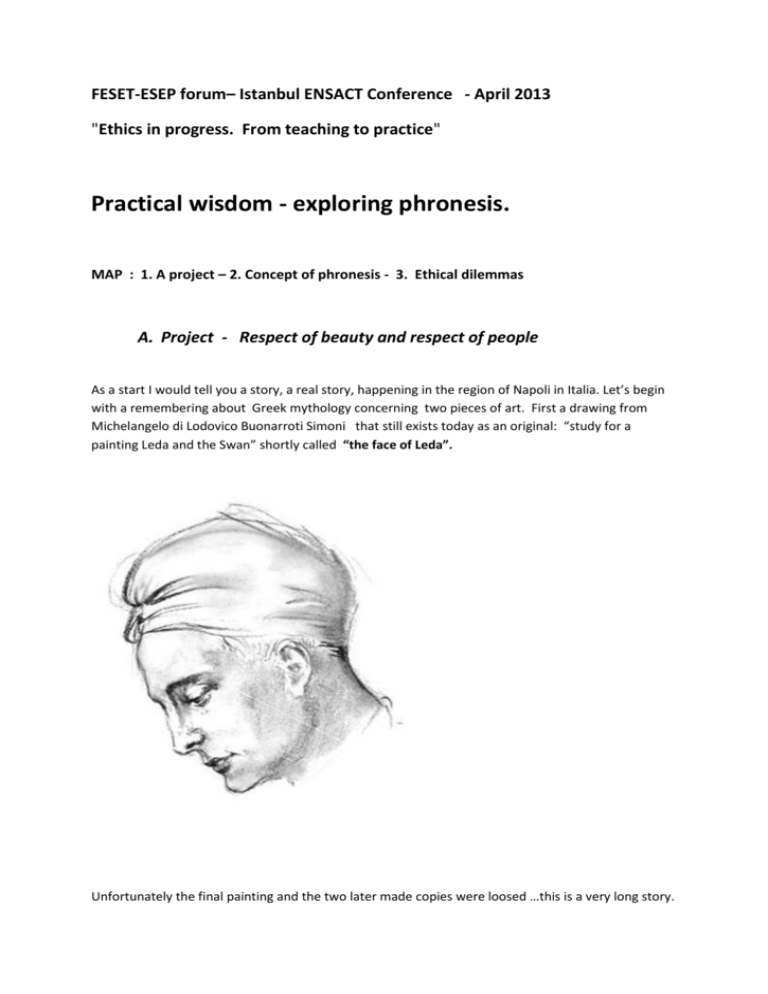
FESET-ESEP forum– Istanbul ENSACT Conference - April 2013 "Ethics in progress. From teaching to practice" Practical wisdom - exploring phronesis. MAP : 1. A project – 2. Concept of phronesis - 3. Ethical dilemmas A. Project - Respect of beauty and respect of people As a start I would tell you a story, a real story, happening in the region of Napoli in Italia. Let’s begin with a remembering about Greek mythology concerning two pieces of art. First a drawing from Michelangelo di Lodovico Buonarroti Simoni that still exists today as an original: “study for a painting Leda and the Swan” shortly called “the face of Leda”. Unfortunately the final painting and the two later made copies were loosed …this is a very long story. And here we see what could be the whole result of the painting of Michelangelo but … painted here by Cesare da Sesto after … a lost painting “Leda and the swan” by Leonardo da Vinci. This scene was also painted by Rubens, Veronese, Tintoret, Boucher, Matisse and more others. I choose this version, first because Leonardo and Michelangelo are from the same region and in rather similar times (around 1500) and secondly, it’s a very good representation of the whole tale from the greek mythology: “Leda and the Swan” is a story and subject in art from Greek mythology in which the god Zeus, in the form of a swan, seduces, or rapes, Leda, wife of Tindareus, king of Sparta. According to later Greek mythology, Leda bore Helen and Clytemnestra, children of Zeus, while at the same time bearing Castor and Pollux, children of her husband Tyndareus. According to many versions of the story, Zeus took the form of a swan and raped or seduced Leda on the same night she slept with her husband King Tyndareus and in some versions, she, he or the two … laid two eggs from where the children came to life…” Let’s come to the socio-artistical dimension of this paper that brings its ethical interest. An innovative project essentially based on arts and social intervention was recently proposed and will take place since he is supported by the italian minister of interior. The project has two parts: 1. An exhibition of the “The face of Leda”, from April to June in a school of Casavatore, a little municipality next to Napoli, and near from Scampia and Secondigliano, two main places of the local mafia, the Camorra. This is for the local people rather incredible! A drawing of Michelangelo coming from a foundation of Firenze (la fundazione Buonnarroti) for being exposed in a school of a poor suburban of Napoli… Very ambitious when we know all the security measures that have to be taken for accompanying such a transfer. And very courageous from the foundation to lend this very precious drawing. The space of the school where the exhibition will take place will be transformed and lighted with special low lights as in the museums, and a guardian in arms will be present 24h/24. This part of the project will cost 150.000 Euros payed by sponsors. This amount also includes a restructuration of several parts of the school and the whole sport hall’s renovation. 2. On a more sustainable way, during this exhibition and after it on a permanent way, an office will be open not far from the school by the municipality for welcoming people of every age who want to denounce the demands they had for a payment of the “pizzo” (the “mafia tax”) of the camorra. In the same time in the school, a teacher and a social educator will be in charge for welcoming the demands of children’s who are victims of “racket” inside or around the school. The originality of the project is to join an action based on a surprise, on a symbolic event (exhibition of a pure beauty inside of a poor and difficult district of a city) with this double message: “here the camorra can’t take us the beauty” – “here beauty is stronger that dark traffics…” and also based on a long term action that is a preventive and proactive work with the citizens and the children of the city of Casavatore, based on the necessity of acting in the everyday life against the bad enterprises of racketing as well in the minds of adults as of children’. B. Aristotelian and Socratic concept of practical wisdom in professional life In Book 6 of the Nichomachean Ethics, Aristotle distinguishes between two intellectual virtues which are sometimes translated as “wisdom”. Sophia and Phronesis. Sophia, sometimes traduced as à “theoretical wisdom” is a combination of nous, the ability to discern reality and episteme, a type of knowledge, rational, logical, which is teachable and sometimes equated with science. Sophia in other words involves reasoning concerning universal truths. Phronesis sometimes traduced as “practical wisdom” also combines a capability of rational thinking with a type of knowledge. On the one hand it requires the capability to rationally consider actions which can deliver desired affects. On the other hands, Aristotle says that phronesis is however not simply a skill -technè- as it involves not only the ability to decide how to achieve a certain end, but also the ability to decide how to achieve a certain end and the ability to reflect upon and determine good ends consistent with the aim of living well overall. Aristotle points out that although Sophia is higher and more serious that phronesis, the highest pursuit of wisdom and happiness requires both, because phronesis facilitates Sophia. He also associates phronesis with political ability, interesting for our story, isn’t it? For connecting our ethical reflection with “the face of Leda”: is this artistico-social project serious, connected with a philo-sophianian dimension? On the theoretical side we have surely, concerning the content of the drawing and of the myth a opportunity of reflecting universal truths who are discussion in the myth as in the pictural representation: intimicy,beauty ,solitude, erotic and love-relation, ( let’s look on the face and the looking of Leda in the drawing of M-A and look then to the same face in the whole scene painted by Da Vinci) , the connection between love or/and seduction, (the symbol of the swan as a paradox of beauty, seduction, violence, with a possible reflexion on the fear, very challenging here when we speak about mafia or racketing…) and pregnancy and possible birth of children, children from same mother and different fathers (two eggs containing each two children… babies surely, but also different values or realities, systems present and active in the same time… and sometime the necessity of choosing… relations between the strong and the weak , the absolute and the contingent , etc.. etc… Those two representations suggest in the same time a paradox: happiness and difficulty of a strange (awful or marvelous) love story. Values expressed in such a beauty - not always evident to capture at the first look but more and more clear when the pedagogical dimension proposed during the exhibition - that benefits are brought as well for pupils of the school that for external visitors of the neighborhood, not used with this kind of esthetical ritual. Yes we are in Sophia! Concerning Phronésis, do we see in this project an opportunity for combining a capability of rational thinking with a type of knowledge? Concerning the knowledge no doubt that this adventure can bring lot of knowledge’s as well in art history and esthetique as in life experience and philosophy. Concerning the way to “achieve a certain end and the ability to reflect upon and determine good ends consistent with the aim of living well overall”: - the end of this project is clearly to fight against the camorra practices in general and precisely against the racket practice who is so sadly shared by the adults and the children in the city of Casavatore. -the ability to reflect upon is encouraged by the pedagogical effort made inside of and around the exhibition. The face of Leda, or better, the head of Leda is a real challenge of the head of each human being, both in her beauty and in her fragility. As can experiment the inhabitants of Casavatore, probably more often on the fragility side that on the beauty side… That’s why this exhibition is a possibility of rebalancing their whole life perception. An opportunity to reflect upon. - determine good ends consistent with the aim of living well overall seem to be the most delicate point. Question of living well in Casavatore is probably to connect with the everyday experience they have as a lonely person (as when they are asked for “pizzo”…) or as a member of a community with their friends, husband or wife, children, grandparents, neighbors…. In conclusion we could summarize this experience as - first a transmission of contents (mainly a drawing and a painting and the story of a myth). second a possibility of reflecting several points between two pictures and between two realities (racket at school and racket everywhere in the society) third the articulation of one shot project and long term social and pedagogical work allows new possibilities… C. Two concrete dilemmas We have now two concrete dilemmas, we could speak together in a socratical dialogue helping us to find good ends consistent with a living well: -The municipality representant (could be a police employee or a social worker… good question) who will be in the bureau, what can he do for giving some ideas to the consultants who come saying I was still asked for giving pizzo and I did it. And how can they encourage them for constructing of a “living well overall”? -The teacher and the social educator who will be concerned with the some questions about racket between youngsters have probably different challenges because we are in a kind of society in reduction called school. But what can they do when the pupils say: I give the “pizzo”. And how can they help them to reflect and to act for a living well overall? In those two dilemmas I would propose several steps of practical wisdom that could be called: vigilance, love, revolt and co-construction 1. 2. 3. 4. vigilance and fine intelligence of the situation love, opening and benevolence critique thinking, resistance, revolt and re-construction capacity of proposition and co-construction That could be a way for thinking practical wisdom as a “mise en mouvement”… François GILLET Istanbul April 2013
